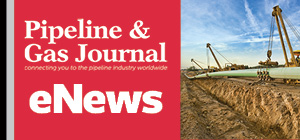Analyst: Argentina's Shale Output to Stall Amid Bottlenecks
(Reuters) — Activity levels are at all-time highs in Argentina's prime oil and gas producing region, but equipment and transport bottlenecks are limiting its growth, an analyst said on Thursday at an energy conference.
The Vaca Muerta shale region in the Neuquen province needs more drilling rigs, hydraulic fracturing fleets and natural gas pipelines transport to continue growing, said Alexandre Ramos, Rystad Energy's vice president of shale research.
"Frac fleet availability is a massive bottleneck," said Ramos. "We are seeing historically high gas production in Neuquen, so upcoming expansions are critical to allow Vaca Muerta to satisfy demand," he said.
The South American country's gas production so far this year is running 132 million cubic meters per day (MMcm/d), according to state-run oil company YPF YPFD.BA, below 2004's peak 142 MMcm/d. Crude oil production this year is running at 559,000 barrels per day ( bbl/d), below the peak 847,000 bbl/d in 1998.
Marcelo Robles, manager of joint venture development at PanAmerican Energy, told the conference, water recycling will be needed to increase output.
"We are using fresh water for fracking. In the future, we need to find a different solution. Sourcing and disposing water are a challenge," said Robles.
Horacio Marin, oil producer Tecpetrol's Exploration and Production chief, said the province could double its crude oil production and grow gas output through 2030 with an additional $7 billion devoted to drilling and completion, and $12 billion in infrastructure investments.
The historical downward trend has been partially offset in recent years by unconventional production of oil and gas coming from Vaca Muerta's shale reserves, according to Francisco Bertoldi, a YPF YPFD.BA vice president of upstream unconventionals.
Argentina expects to begin construction on a gas pipeline from Vaca Muerta to hubs in the North this year that beginning next year will ease bottlenecks that have kept pipeline utilization rates at over 90%. Exports through another gas line to Chile could also help ease the transportation issues.
A second segment of the gas pipeline to the North has not yet been put to auction.
Related News
Related News

- Freeport LNG Plant Runs Near Zero Consumption for Fifth Day
- Biden Administration Buys Oil for Emergency Reserve Above Target Price
- Mexico Seizes Air Liquide's Hydrogen Plant at Pemex Refinery
- Kinder Morgan Declares Force Majeure on West Texas Gas Pipeline After Fire
- Williams Delays Louisiana Pipeline Project Amid Dispute with Competitor Energy Transfer
- Pipeline Hydro Test Pressure Determination
- Venezuela Proposes Alternative Payment Plan as Weak Bids Surface in Citgo Auction
- Baker Hughes Wins Contract for Huge Aramco Gas Expansion Project
- Japan Looks at Developing Domestic Pipelines Sector
- Enbridge Picks Contractors for Great Lakes Tunnel Project, Securing Line 5 Pipeline Route





Comments